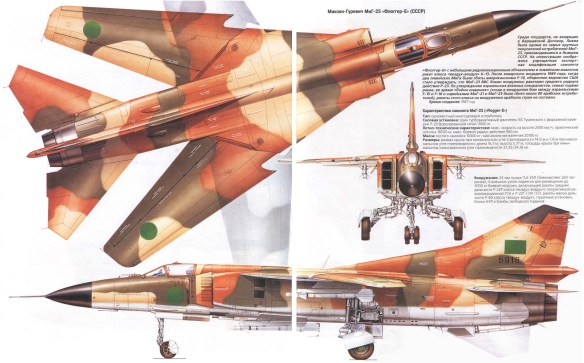
The MiG 23 was the first Soviet combat plane equipped with variable-wing geometry. Its success led to an equally capable ground-attack version, the MiG 27.
By the mid-1960s the Red Air Force wanted to supplement its vaunted MiG 21s with air-superiority fighters that could also perform ground-attack work. The new machine would have to approximate the formidable performance of such Western stalwarts as the F-4 Phantom and F-105 Thunderchief. Furthermore, excellent STOL (short takeoff and landing) ability from unfinished fields was also required. The Mikoyan design bureau initially toyed with revised delta configurations before settling upon a “swing-wing” version like the General Dynamics F- 111. The new MiG 23 prototype first flew in 1967 as a high-wing jet with an extremely sharp profile. The wing could be deployed at three different angles for takeoff, cruise, and fighting mode and, when fully extended, would assist in achieving shorter landing distances. To ensure high performance at high speed, the craft also carried adjustable “splitters” at the front of each air intake. The first MiG 23s had no sooner been deployed in 1970 than it was determined to optimize them for air supremacy and forego ground-attack functions for a subsequent model.
The impracticality of endowing the MiG 23 with good tactical strike abilities led to development of a related design, the MiG 27. This was essentially a stripped-down MiG 23 refitted with a distinct flattened nose housing a laser range finder. The craft lost its intake splitters, as excessively high speed is considered unnecessary at low altitude. The afterburner was also simplified and lightened to compensate for weight lost at the front end. Not surprisingly, Soviet pilots dubbed the MiG 27 Utkonos (Duck-nose) on account of its odd appearance. More than 3,000 of both versions have been built, and collectively they are identified by the NATO designation FLOGGER. Neither craft is considered a match for their Western equivalents.